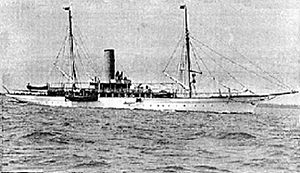HMY Iolaire facts for kids

As Amalthaea in 1908
|
|
Quick facts for kids History |
|
|---|---|
| Name | Iolaire |
| Namesake | Eagle (in Scottish Gaelic) |
| Owner | Royal Navy |
| Launched | 1881 |
| Fate | Wrecked, 1 January 1919 |
| General characteristics | |
| Class and type | Yacht |
The His Majesty's Yacht Iolaire was a special ship used by the British Admiralty. Its name, Iolaire, means "Eagle" in Scottish Gaelic. This yacht tragically sank near Stornoway harbour on the Isle of Lewis on 1 January 1919.
The sinking of the Iolaire was one of the worst sea disasters in UK waters during the 20th century. Even though the ship hit rocks very close to shore, at least 201 men out of 283 on board died. Most of these men were Royal Navy Reservists. They were returning home after fighting in the First World War. Terrible weather and rough seas made the disaster much worse.
Contents
The Iolaire Disaster
The Iolaire was bringing sailors home after World War I. These men were from the Isle of Lewis in the Outer Hebrides, Scotland. The ship left the port of Kyle of Lochalsh on the evening of 31 December 1918.
Ship Hits Rocks
At 2:30 a.m. on New Year's Day, the ship was close to Stornoway port. It was only a few yards from the shore. However, it hit dangerous rocks known as "The Beasts of Holm." The ship sank quickly. The men on board could even see the lights of Stornoway, so close to safety.
Lives Lost and Heroism
The official number of deaths was 205. Of these, 181 men were islanders from Lewis. However, the ship was very crowded, and records were not perfect. So, the actual number of lives lost might have been higher.
A brave man named John F. Macleod from Ness, Isle of Lewis saved many lives. He swam ashore with a rope. About 40 survivors used this rope to reach safety. Out of 283 known passengers, only 82 survived. This means 71 percent of the people on the yacht died.
Impact on the Islands
The disaster had a huge impact on the Islands. Losing 205 passengers meant that almost a whole generation of young men from the Islands was gone. Many of the sailors wore heavy uniforms and boots. This made it very hard for them to swim from the wreck. Also, many men at that time had never learned how to swim.
Songs and poems, like An Iolaire, tell the sad story. They describe how the women of these men found their loved ones washed up on the shore the next day. This sinking was the worst peacetime sea disaster in UK waters since the wreck of the SS Norge in 1904. It was also the worst peacetime disaster involving a British ship since the Titanic sank in 1912.
Why Did It Happen?
The British Admiralty held an investigation to find out why the disaster happened. However, they could not find a clear reason. Their findings were not conclusive. This made many people on Lewis unhappy. They felt that the full truth wasn't revealed.
The ship was sailing at night. The weather was bad, and it was hard to see. Entering Stornoway harbour can be tricky. It is possible that the ship made a mistake in its navigation. The crew of a fishing boat nearby also noticed that the Iolaire was not on the correct path to enter the harbour.
Remembering the Iolaire
A memorial was built in 1958 at Holm, near Stornoway. A stone pillar stands in the water at the wreck site. You can see it when the car ferry approaches the harbour.
Centenary Commemoration
On 1 January 2019, people remembered 100 years since the disaster. Many events took place. Musicians like Julie Fowlis and Duncan Chisholm performed. Local artists also created works. The disaster is part of a project called "Living Legacies (1914-18)." This project helps people understand the deep loss felt by families and communities.
A national service was held at the memorial on 1 January 2019. The First Minister of Scotland, Nicola Sturgeon, attended. Prince Charles, Duke of Rothesay, also attended. He unveiled a new memorial at Holm. This new memorial shows the rope used by John F. MacLeod to save 40 lives.

